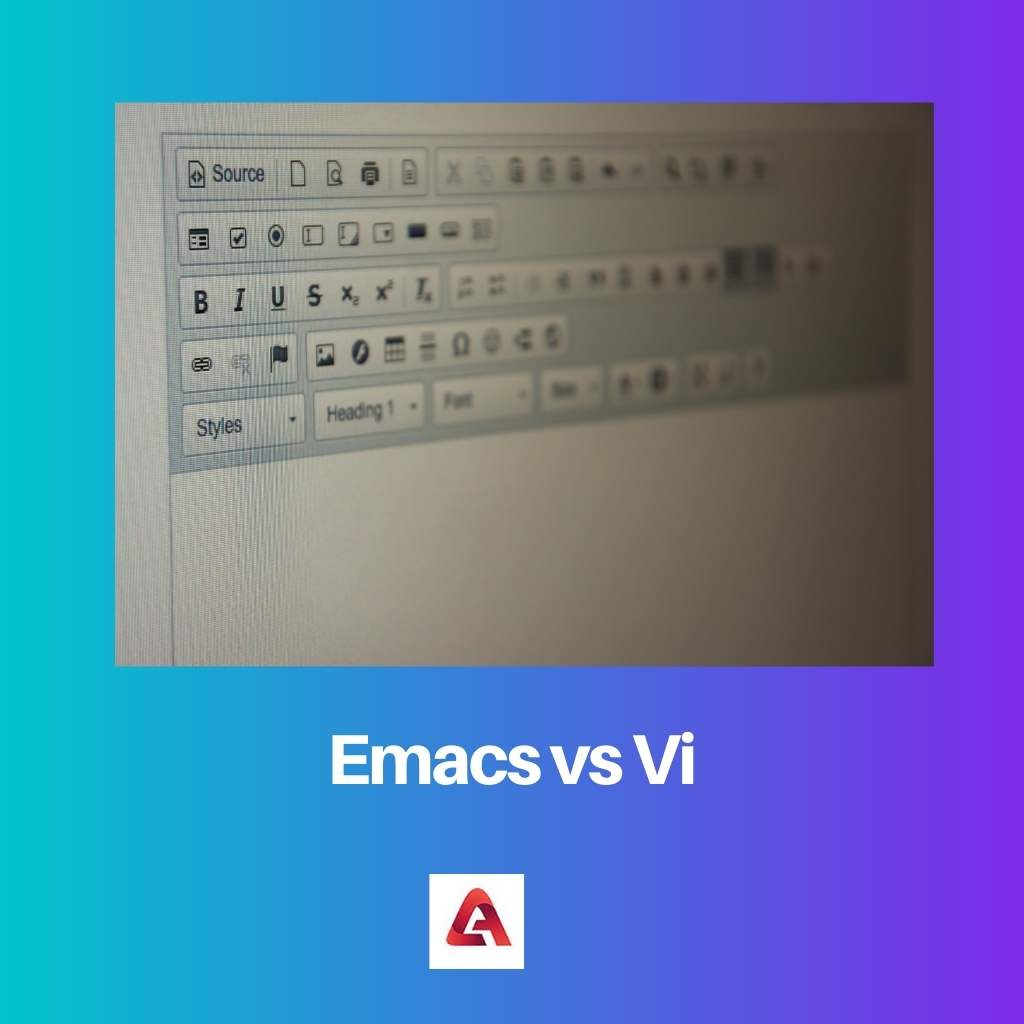In the earlier days,’ Emacs’ and ‘Vi’ are considered as two popular contenders of text editors. Nowadays, As you web browser wars, there are many software fighting for their position.
There was the same editor war between them. People tend to take them as similar software, however, they are very different from each other from speed to response.
Key Takeaways
- Emacs is a highly extensible text editor with numerous built-in functions, while Vi is a smaller, more lightweight editor.
- Vi uses a modal interface with different modes for editing and navigating, whereas Emacs uses key combinations for commands.
- Emacs allows for the simultaneous editing of multiple files, while Vi is designed for editing one file at a time.
Emacs vs Vi
Emacs is a customizable and self-documenting text editor with many features, including syntax highlighting, spell-checking, and a powerful macro system. Vi is a modal text editor that comes in two versions: Vi and Vim, using command mode to perform actions on the text.

Emacs is a text editor that was used in Unix or Unix-like operating systems. Emacs are slower and heavier as compared to Vi.
Although, it has many benefits, too, such as extensive customizability, and also allows users to incorporate a wide variety of macros into their work and reduce the effort. Moreover, it is also developed GUI and further developed its software.
Vi is also a text editor that was used in Unix or Unix-like operating systems. Vi is faster and lighter as compared to emacs. Although, it has many benefits too, such as faster speed and response.
However, Vi lacks customizability, and uses a simple and direct process. And it doesn’t develop its GUI. Lastly, Vi is superseded by other versions.
Comparison Table
| Parameters of comparison | Emacs | Vi |
|---|---|---|
| Speed | Emacs are slower and heavier. | Vi is faster and lighter. |
| Response | Emacs have a slower response. | Vi has a faster response. |
| Customizability | Emacs is customizable. | Vi is not. |
| Surpass | Emacs surpassed Vi. | Vi is not able to surpass emacs. |
| Developed GUI | Emacs also developed GUI. | Vi didn’t develop GUI. |
| Developing | Emacs is further developing its software. | Vi is superseded by others. |
What is Emacs?
Emacs is a text editor software that was widely used before. It was created by Richard Stallman in 1976.
Emacs and Vi were contenders for best editor software, thus, it is one of the debates of the original holy wars conducted on Usenet groups.
The keystroke execution in Emacs is a key combination where modifier keys are pressed along with alphanumerical keys. Ultimately, a command is executed once it is typed completely.
Moving to memory usage and customizability, larger storage is needed, and it takes longer to start up. However, it has high customizability with a variety of features.
As for the user environment, it is further developing and developing its GUI to be compatible and support other features as well, such as proportionate spacing and font-size variation. And it also supports embedded images and hypertext.
Emacs use prefix keys along with additional keys are pressed that constitute a key binding. And it uses modifier keys, such as escape, meta, alt, control, and shift, and all of this concludes most of the used modifier keys.
Moreover, it also supports all Unicode-type writing systems as well as allows writing multiple scripts to be incorporated into each other.
Emacs’s non-modal interface makes it possible to be supported as OS-wide keybindings.
What is Vi?
Vi is also a text editor software that was widely used before. It was created by Bill Joy in 1976.
Emacs and Vi were contenders for best editor software, thus, it is one of the debates of the original holy wars conducted on Usenet groups.
The keystroke execution in Vi works a little differently as Vi preserves each typed key and executes the commands. Moving to memory usage and customizability, it is considered small, thus, it doesn’t offer customizability due to its less capacity.
However, it is faster as compared to Emacs. For small texts, the vi starts instantaneously.
As for the user environment, It is originally used as a text-mode console without GUI. Moreover, it doesn’t support proportionally spaced fonts and also different sized fonts in the same document.
Vi uses a different function interface of distinct editing modes. There are two modes; insert mode and normal mode. Insert mode allows keys to insert characters into the text, while normal mode allows entering commands using bare keypresses.
And it also does not use Alt or Ctrl, however, it uses alphanumeric keys and the escape key. Thus, it minimizes awkward finger reaches.
Moreover, it only has rudimentary support for other languages besides English.
Vi has a modal interface and a faster response than Emacs.
Main Differences Between Emacs and Vi
Web browsers are popular contenders in computer software. However, before all this, Emacs and Vi are commonly used as text editors in Unix and Unix-like operating systems.
The same contenders were seen in these two text editors. People seem to take them as similar software, however, they are very different from each other. The major difference between them is the speed.
- Emacs are slower and heavier. Meanwhile, Vi is faster and lighter.
- Emacs have a slower response, while vi has a faster response.
- Emacs is customizable, while vi is not.
- Emacs surpassed Vi, while Vi is not able to surpass Emacs.
- Emacs also developed GUI, while Vi didn’t develop GUI.
- Emacs is further developing its software. Meanwhile, Vi is superseded by others.




